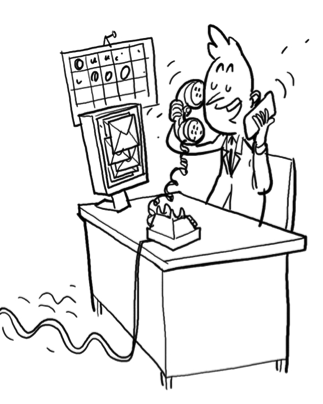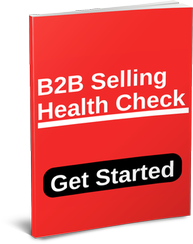 See if this scenario rings any bells. You’ve had a great first meeting with a client and they seem really keen to do business with you but when you follow up they say they can’t do anything right now, call back in 6 months. But 6 months later you hear they have started to do business with a competitor. This sort of thing happens all the time. You might even have submitted a proposal but then everything goes quiet. This is where the need for persistence comes in.
See if this scenario rings any bells. You’ve had a great first meeting with a client and they seem really keen to do business with you but when you follow up they say they can’t do anything right now, call back in 6 months. But 6 months later you hear they have started to do business with a competitor. This sort of thing happens all the time. You might even have submitted a proposal but then everything goes quiet. This is where the need for persistence comes in.
Persistence may not sound very exciting but it does get some very exciting results. Let me walk you through an example.
If at first you don’t succeed
A company I work with designs and produces bottling lines for drinks manufacturers. When we first met them, they thought they were great sales people but the truth was they had such a good product that they were more like order takers, at best they were making features and functions sales.
We made a presentation to them and they acknowledged the benefits sales training would deliver but it wasn’t really very high on their list of priorities. That was in 2007. In 2009 following a global economic downturn their turnover plummeted – now they were interested in improving sales performance!
I had tried to stay in touch with the Head of Global Sales, but he didn’t return my calls. His deputy, however, did and I stayed in touch with her over the 2 years. We didn’t get handed the work on a plate, there was a competitive pitch against 4 other suppliers. But because we knew about the pitch early on we were able to influence the way it was run and in 2010 we won a very valuable piece of business against much bigger competitors.
Persistence paid off.
Urgency radar
Persistence doesn’t mean wasting your time chasing business you will never win. It’s important to qualify leads in the first place and to update that qualification regularly – to identify where your proposal is on what I call the prospects ‘Urgency Radar’. This can change at any time. Sometimes you can walk out of a meeting with your proposal at the top of the customer’s agenda, they really mean it when they say they will get back to you but then something happens and things have changed within a day or even an hour.
For instance, one of our clients wanted to implement an Account Development Program this year that would have given them a good Return on Investment (ROI) but over the long term. Then they lost a big deal with a short-term impact and so the project was postponed because they had no funds for something with just a long-term impact. We had to rethink our offering to get back on their Urgency Radar.
Persistence as part of the sales culture
The problem with persistence is that it isn’t sexy and it’s hard work. Done poorly it is seen by customers as pestering. But done professionally persistence can become a key differentiator.
One of my clients is a technical leader in their field and they run regular open days. They invite everyone including the press, suppliers, existing customers and of course prospective customers. All the people who attend have the opportunity to learn about the company, new products and success stories - but there is also plenty of scope for networking and for Sales People to reconnect with prospects.
Other companies sponsor sporting or cultural events and use them as networking events so they can talk to prospects that have gone a little cool.
5 tips for the persistent Sales Person
-
Always remind people of their pain and your value proposition. For instance; “You talked to us about your need to increase sales leads and we showed how we could help to deliver an extra 25%”. Use that in the title of follow up emails, calls and voice mails.
-
Find something new and exciting to discuss. You could talk about developments in their competitive landscape or recent examples of how you’ve helped companies like them. I recently submitted a proposal to a large electronics company, but soon after I thought of a better way to help them achieve their goals. So I called them up to discuss the alternative and they told me they were impressed that I was thinking about them.
-
Get your timing right. In the meeting or presentation, ask them about the best time to follow up. They are more likely to take a call at a time they have agreed. Even if it is 5 o’clock next Tuesday morning don’t miss that slot.
-
Give them value in the gap. Between the contact and the agreed follow up you should try and help your contact with anything from valuable blog content to information about their market or competitors. Best of all, ask if you can work on a small project that will show them what it will be like to work with you.
-
Plan your persistence. It’s all very well having follow ups on your To Do list but we all know what happens to the things at the bottom of the list – they don’t get done. Schedule in the calls you have agreed and make time for the other follow ups then plan how you can effectively keep in touch with other prospects. Make persistence a core competence in your organisation not a chore.
Gatekeepers
Sometimes you can run up against a block. It might be that you have called a person several times but they have failed to get back to you. If you suspect this is happening try getting another member of the team to call, maybe as a direct follow up or about something related just to overcome the block.
Another situation is when an individual may not be in favour of your solution and is trying to put you off. If you are certain that you are never going to get a result by talking to this individual what have you got to lose if you go around them and talk to someone else?
Persistence is not easy and it may not seem as cool as going after new prospects or participating in pitches. But a well-qualified lead where you have already made some progress is more likely to convert than a totally new one.
Ask yourself
-
Do you schedule follow up calls at the end of meetings?
-
Do you try and deliver value as part of your follow up campaign?
-
Do you Plan for Persistence – is yours a persistent culture?
Score yourself against 20 Success Factors with our B2B Selling Health Check:

